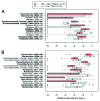The intestinal microbiome, probiotics and prebiotics in neurogastroenterology
- PMID: 23202796
- PMCID: PMC3555881
- DOI: 10.4161/gmic.22973
The intestinal microbiome, probiotics and prebiotics in neurogastroenterology
Abstract
The brain-gut axis allows bidirectional communication between the central nervous system (CNS) and the enteric nervous system (ENS), linking emotional and cognitive centers of the brain with peripheral intestinal functions. Recent experimental work suggests that the gut microbiota have an impact on the brain-gut axis. A group of experts convened by the International Scientific Association for Probiotics and Prebiotics (ISAPP) discussed the role of gut bacteria on brain functions and the implications for probiotic and prebiotic science. The experts reviewed and discussed current available data on the role of gut microbiota on epithelial cell function, gastrointestinal motility, visceral sensitivity, perception and behavior. Data, mostly gathered from animal studies, suggest interactions of gut microbiota not only with the enteric nervous system but also with the central nervous system via neural, neuroendocrine, neuroimmune and humoral links. Microbial colonization impacts mammalian brain development in early life and subsequent adult behavior. These findings provide novel insights for improved understanding of the potential role of gut microbial communities on psychological disorders, most particularly in the field of psychological comorbidities associated with functional bowel disorders like irritable bowel syndrome (IBS) and should present new opportunity for interventions with pro- and prebiotics.
Keywords: biomarkers; gastrointestinal tract; human trials; immune; microbiome; microbiota; neurogastroenterology; prebiotic; probiotic.
Figures



Similar articles
-
Mind-altering with the gut: Modulation of the gut-brain axis with probiotics.J Microbiol. 2018 Mar;56(3):172-182. doi: 10.1007/s12275-018-8032-4. Epub 2018 Feb 28. J Microbiol. 2018. PMID: 29492874 Review.
-
Stress and the gut: pathophysiology, clinical consequences, diagnostic approach and treatment options.J Physiol Pharmacol. 2011 Dec;62(6):591-9. J Physiol Pharmacol. 2011. PMID: 22314561 Review.
-
Modulation of Gut Microbiota-Brain Axis by Probiotics, Prebiotics, and Diet.J Agric Food Chem. 2015 Sep 16;63(36):7885-95. doi: 10.1021/acs.jafc.5b02404. Epub 2015 Sep 1. J Agric Food Chem. 2015. PMID: 26306709 Review.
-
Psychological comorbidity in gastrointestinal diseases: Update on the brain-gut-microbiome axis.Prog Neuropsychopharmacol Biol Psychiatry. 2021 Apr 20;107:110209. doi: 10.1016/j.pnpbp.2020.110209. Epub 2020 Dec 14. Prog Neuropsychopharmacol Biol Psychiatry. 2021. PMID: 33326819 Free PMC article. Review.
-
Irritable bowel syndrome: a model of the brain-gut interactions.Med Sci Monit. 2004 Apr;10(4):RA55-62. Med Sci Monit. 2004. PMID: 15260348 Review.
Cited by
-
Personalizing Nutrition Strategies: Bridging Research and Public Health.J Pers Med. 2024 Mar 13;14(3):305. doi: 10.3390/jpm14030305. J Pers Med. 2024. PMID: 38541047 Free PMC article. Review.
-
Memory Reflections of the Microbiota-Gut and Oligodendrocyte Axis.CNS Neurol Disord Drug Targets. 2024;23(8):971-983. doi: 10.2174/0118715273256132230921103333. CNS Neurol Disord Drug Targets. 2024. PMID: 37855297 Review.
-
Effect of prebiotics, probiotics, synbiotics on depression: results from a meta-analysis.BMC Psychiatry. 2023 Jun 29;23(1):477. doi: 10.1186/s12888-023-04963-x. BMC Psychiatry. 2023. PMID: 37386630 Free PMC article.
-
Red Ginseng Dietary Fiber Shows Prebiotic Potential by Modulating Gut Microbiota in Dogs.Microbiol Spectr. 2023 Aug 17;11(4):e0094923. doi: 10.1128/spectrum.00949-23. Epub 2023 Jun 27. Microbiol Spectr. 2023. PMID: 37367492 Free PMC article.
References
Publication types
MeSH terms
Substances
Grants and funding
LinkOut - more resources
Full Text Sources
Other Literature Sources
